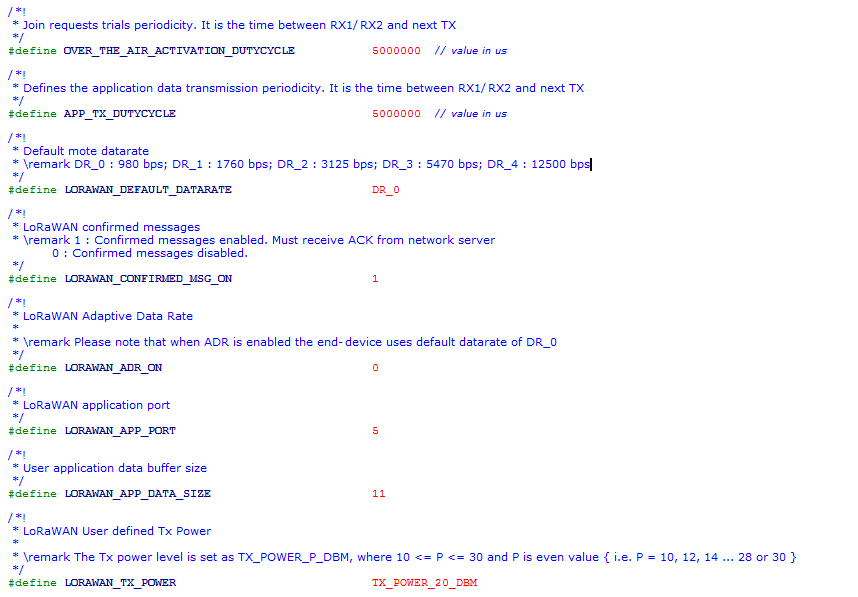SX1276 Shield based Applications
Dependencies: X_NUCLEO_IKS01A1 LoRaWAN-lib SX1276Lib mbed
LoRaWAN-SX1276-Application Demo uses SX1276MB1LAS mbed component shield on a nucleo board platform to demonstrate a Class-A LoRaWAN device in the 915MHz ISM band for North American region. It uses the LoRaWAN-lib and SX1276Lib libraries.
Comissioning.h (LoRaWAN Network Configuration)
The end-device can be activated in one of the two ways:
Over the Air (OTA) activation can be enabled as shown in the figure below.

The end-device must be configured with the following parameters:
LORAWAN_DEVICE_EUI(8 Bytes) : Fist 3 Bytes is the Organizationally Unique Identifier (OUI) followed by 5 bytes of unique ID. If not defined by user, then the firmware automatically assigns one to the end-deviceLORAWAN_APPLICATION_EUI(8 Bytes)LORAWAN_APPLICATION_KEY(or DEVKEY) (16 Bytes)

Activation by Personalization (ABP) can be enabled as shown in the figure below.

The end-device must be configured with the following parameters:
LORAWAN_DEVICE_ADDRESS(4 Bytes) : If not defined by user, then the firmware automatically assigns one to the end-deviceLORAWAN_NWKSKEY(16 Bytes)LORAWAN_APPSKEY(16 Bytes)

Config.h (LoRaWAN Communication Parameters)
- Mode of Operation : Hybrid
If the end-device needs to be configured to operate over 8-channels, then
Hybrid Modeneeds to be enabled
- Mode of Operation : Frequency Hop
If the end-device needs to be configured to operate over 64-channels, then
Hybrid Modeneeds to be disabled
- Delay between successive JOIN REQUESTs :
The delay between successive Join Requests (until the end-device joins the network) can be configured using the parameter
OVER_THE_AIR_ACTIVATION_DUTYCYCLE
- Inter-Frame Delay :
One can change the delay between each frame transmission using
APP_TX_DUTYCYCLEIt is advisable thatAPP_TX_DUTYCYCLEis greater than or equal to 3sec.
- Data Rate :
The data rate can be configured as per LoRaWAN specification using the paramter
LORAWAN_DEFAULT_DATARATE. The range of values are DR_0, DR_1, DR_2, DR_3 and DR_4
- Confirmed/Unconfirmed Messages :
The uplink message or payload can be chosen to be confirmed or unconfirmed using the parameter
LORAWAN_CONFIRMED_MSG_ON. When set to 1, the transmitted messages need to be confirmed with anACKby the network server in the subsequent RX window. When set to 0, noACKis requested.
- ADR ON/OFF :
The ADR can be enabled or disabled using the parameter
LORAWAN_ADR_ON. When set to 1, ADR is enabled and disabled when set to 0.
- Application Port :
The application port can be set using parameter
LORAWAN_APP_PORT. A few examples are associated to specific Application Port, and are defined in Config.h
- Payload Length :
The lenght of the payload (in bytes) to be transmitted can be configured using
LORAWAN_APP_DATA_SIZE
- Transmit Power :
The transmit power can be configured using
LORAWAN_TX_POWER(LoRaMAC verifies if the set power is compliant with the LoRaWAN spec and FCC guidelines)

The baud-rate for serial terminal display is 115200
app/SerialDisplay.cpp
- Committer:
- ubhat
- Date:
- 2018-07-18
- Revision:
- 6:c5f2da0de0b0
- Parent:
- 0:42863a11464a
File content as of revision 6:c5f2da0de0b0:
/*
/ _____) _ | |
( (____ _____ ____ _| |_ _____ ____| |__
\____ \| ___ | (_ _) ___ |/ ___) _ \
_____) ) ____| | | || |_| ____( (___| | | |
(______/|_____)_|_|_| \__)_____)\____)_| |_|
(C)2015 Semtech
Description: VT100 serial display management
License: Revised BSD License, see LICENSE.TXT file include in the project
Maintainer: Miguel Luis and Gregory Cristian
*/
#include "SerialDisplay.h"
VT100 vt( USBTX, USBRX );
void SerialDisplayJoinUpdate( void )
{
printf( "###### ===== JOINING ==== ######\r\n" );
DisplayNetworkParam( );
printf( "\r\n" );
}
void SerialDisplayTxUpdate(void)
{
printf( "###### ===== UPLINK FRAME %d ==== ######\r\n", LoRaMacUplinkStatus.UplinkCounter );
DisplayNetworkParam( );
printf( "TX PORT: %d\r\n", LoRaMacUplinkStatus.Port );
if( LoRaMacUplinkStatus.BufferSize != 0 )
{
printf( "TX DATA: " );
if( LoRaMacUplinkStatus.Type == MCPS_CONFIRMED )
{
printf( "CONFIRMED\r\n" );
}
else
{
printf( "UNCONFIRMED\r\n" );
}
SerialDisplayHex( LoRaMacUplinkStatus.Buffer, LoRaMacUplinkStatus.BufferSize );
}
printf( "DATA RATE: DR%d\r\n", LoRaMacUplinkStatus.Datarate );
printf( "TX POWER: %d dBm\r\n", 30 - ( LoRaMacUplinkStatus.TxPower << 1 ) );
printf( "BATTERY: %2.2fV\r\n", BoardGetBatteryLevel( ) );
printf( "\r\n");
}
void SerialDisplayRxUpdate( void )
{
printf( "###### ===== DOWNLINK FRAME %d ==== ######\r\n", LoRaMacDownlinkStatus.DownlinkCounter );
printf( "RX WINDOW: %d\r\n", LoRaMacDownlinkStatus.RxSlot + 1 );
printf( "RX PORT: %d\r\n", LoRaMacDownlinkStatus.Port );
if( LoRaMacDownlinkStatus.BufferSize != 0 )
{
printf( "RX DATA: \r\n" );
SerialDisplayHex( LoRaMacDownlinkStatus.Buffer, LoRaMacDownlinkStatus.BufferSize );
}
printf( "RX RSSI: %d\r\n", LoRaMacDownlinkStatus.Rssi );
printf( "RX SNR: %d\r\n", LoRaMacDownlinkStatus.Snr );
printf( "\r\n" );
}
void SerialDisplayHex( uint8_t *pData, uint8_t len )
{
int i;
bool newline = 0;
for( i = 0; i < len; i++ )
{
if( newline != 0 )
{
printf( "\r\n" );
newline = 0;
}
printf( "%02X ", pData[i] );
if( ( ( i + 1 ) % 16 ) == 0 )
{
newline = 1;
}
}
printf( "\r\n" );
}
void SerialAcclMetrDisplay( uint8_t statusReg )
{
printf( "===== DEVICE ORIENTATION ====\r\n" );
if( ( statusReg & 0x40 ) != 0 )
{
printf( "HORIZONTAL + " );
if( ( statusReg & 0x01 ) != 0 )
{
printf( "FACE DOWN" );
}
else
{
printf( "FACE UP" );
}
}
else
{
printf( "VERTICAL" );
}
printf( "\r\n\r\n" );
}
void DisplayNetworkParam( void )
{
#if( OVER_THE_AIR_ACTIVATION != 0 )
printf( "DEVEUI: " );
SerialDisplayHex( DevEui, 8 );
printf( "APPEUI: " );
SerialDisplayHex( AppEui, 8 );
printf( "APPKEY: " );
SerialDisplayHex( AppKey, 16 );
#else
printf( "DEVADDR: " );
uint8_t *pData = ( uint8_t* )&DevAddr;
for( int32_t i = 3; i >= 0; i-- )
{
printf( "%02X ", pData[i] );
}
printf( "\r\n" );
printf( "NWKSKEY: " );
SerialDisplayHex( NwkSKey, 16 );
printf( "APPSKEY: " );
SerialDisplayHex( AppSKey, 16 );
#endif
}